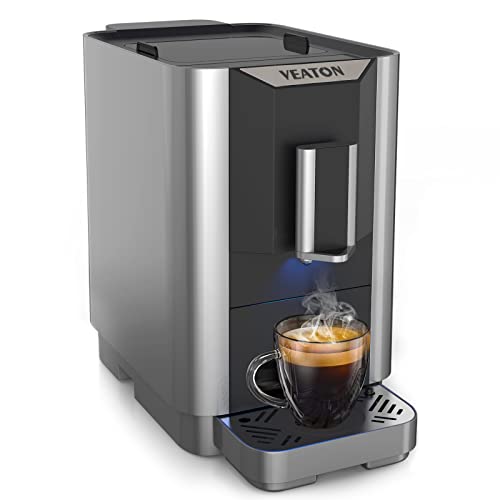Quiz: How Much Do You Know About Espresso Machine Coffee?

How to Make Espresso Machine Coffee
Espresso machines can make an amazing cup of coffee, however they require more care and setup than a typical coffee maker. It also requires you to grind and make your own coffee.
The primary ingredient to make espresso is pressure. Here's how an espresso machine operates: a heating vessel warms water to the perfect temperature, and then pushes it through the grounds and out the spouts.
Temperature
Espresso is produced by forcing hot water through finely ground coffee. espresso machines uk of the water is vital to the final shot. Insufficient temperatures can result in the less extraction of essential flavor compounds. High temperatures produce over extraction, which can result in burnt or bitter tastes.
The ideal temperature range for espresso is 195-205degF. This temperature can be achieved using a grouphead that is designed to ensure a constant temperature and stability throughout the brewing process. The most well-known type of group head is the E61, which provides a combination of temperature stability, pre-infusion capabilities, and lever control.
It is crucial to consider the temperature when you adjust your espresso machine for different roasts or brew ratios. This can affect the extraction yield and the crema. The ideal temperature will differ according to the bean and roast. However it is a general rule that lighter roasts with higher brew rates require higher temperatures. In addition, a top thermocouple is crucial to ensure a constant temperature.
Pressure
During the brewing procedure espresso machine coffee is pushed through finely ground coffee grounds that have been put through a tamper. This causes chemical reactions that remove flavors, oils and other soluble ingredients. The resulting beverage is typically more flavorful and richer than regular coffee.
The ideal espresso machine's pressure is nine bars of pressure that's the same as the atmospheric pressure at sea level. This is due to the fact that it's at this pressure that the soluble compounds in espresso beans are the easiest to extract.
Some espresso machines boast up to 20 bars of pressure. While these machines may achieve these levels of pressure however, they may not be able to maintain the pressure level throughout the extraction.
One bar of pressure is equal to 32 pounds per square inch (PSI) of the tire of a car. It's also more than four times the amount of pressure that professional cyclists use when filling their bicycle tires. Any serious home barista has to be able manage the pressure of their espresso machine to produce consistent espressos.
Water
The water you use in your espresso maker is one of the most crucial elements of a good cup of coffee. The correct water will assist your beans in reaching their full potential, and the wrong water could cause issues like clogged pipes, or even harm your expensive espresso machine.
The best option is natural spring water that is high in minerals for ideal espresso extraction. This water will elevate the flavor of your coffee without the chalky mineral traces you get from tap or bottled waters. This is a great alternative to distilled water or reverse osmosis, which can be too filtered and cause issues with flavor.
It is not recommended to use a water filtering system that removes too much mineral content from the water you drink. This can cause flavor and extraction issues. A good solution is to purchase an instrument for testing water, which will give you the local average hardness. This information can be used to determine the best filtration system for your espresso machine.
Beans

Most coffee aficionados tend to become enthralled in the whole process of making espresso. They are obsessed with a variety of factors, such as temperature, pressure of water and viscosity. If one of the variables is not working, even a little the whole shot may taste bad.
The most important aspect when it comes to espresso is the beans used. Many people believe that only certain types are suitable for espresso. While certain beans are to be used for specific purposes however, any roast can be used for espresso. The main difference between espresso beans and regular coffee beans is that espresso beans are roasted more in tipycally, well past the second crack, which gives them a darker appearance and makes them more water-soluble.
Dark or medium roasted beans are ideal for espresso, as they give espresso shots a richness and a boldness. Lightly roasted beans can be used to make excellent espresso, especially if they are pre-ground to make it easier to use an espresso maker.
Milk
Espresso and milk are a classic combination. The coffee doesn't just increase energy levels, but the steaming milk helps to balance the bitterness of espresso and also adds a wonderful creaminess. There are few culinary duos more perfect than this one!
When selecting an espresso maker capable of making latte or cappuccino too you need to think about how easy it is to use. A lot of the top espresso machines come with an ice jug that can be filled with hot or cold milk, a steam wand and a portafilter that allows you to take the shot. Some models have an integrated grinder, tamper and frother.
To eliminate any condensed water the steam wand needs to be purged each day before use (or after each espresso cup). This process is only 30 seconds, but it's vital to ensure that your machine stays running smoothly. Failure to cleanse can cause an unpleasant taste or the build-up of bacteria which can alter the taste and smell of your beverages. It's easy to do and should be part of your regular maintenance routine.
